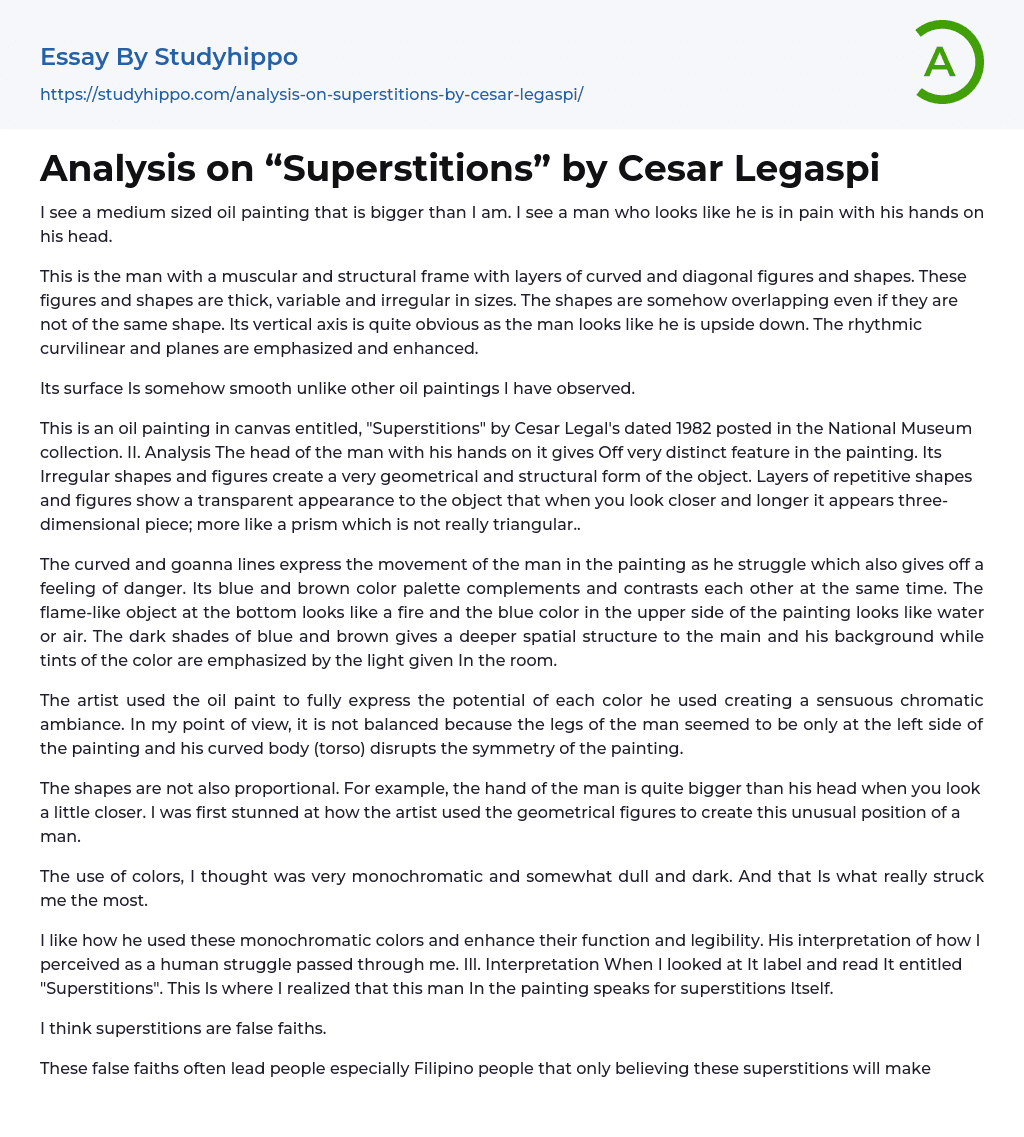

Analysis on “Superstitions” by Cesar Legaspi Essay Example
In front of me is a medium-sized oil painting, larger than me. It depicts a man with his hands on his head, appearing to be in pain. The man has a muscular and structural frame, with layers of curved and diagonal figures and shapes overlapping each other. These shapes are thick, variable and irregular in size, emphasizing the rhythmic curvilinear and planes of the painting. The vertical axis of the painting is apparent, as the man seems to be upside down. The oil painting on canvas is titled "Superstitions" by Cesar Legal from 1982, and is in the National Museum collection. The surface of the painting is notably smooth, unlike other oil paintings I have seen.
Analyzing the painting, it becomes clear that the man's head with his hands on it is a distinct feature of the artwork. Irregular shapes and
...figures create a geometrical and structural form of the object. Layers of repetitive shapes give the object a transparent appearance that appears three-dimensional upon closer inspection, resembling a prism that is not triangular. The movement of the man depicted in the painting is conveyed through curved and goanna lines which create an sense of struggle and danger. Complementary blue and brown colors also provide contrast to each other in the painting.
The painting features a flame-like object at the bottom resembling fire, while the blue hues in the upper portion evoke water or air. The artist masterfully employs oil paint to create a sensual chromatic ambiance, with dark blue and brown tones adding depth and light emphasizing color tints. Despite these impressive techniques, the painting lacks balance as the man's legs appear only on
the left side, and his curved torso disrupts symmetry. Additionally, some shapes lack proportionality, such as the man's hand appearing larger than his head upon closer examination. Nevertheless, the artist's use of monochromatic colors effectively conveys a sense of human struggle. Upon discovering the painting's title, "Superstitions," the viewer realizes that the piece speaks to the falsehoods inherent in superstitions.
Believing in false faiths can be tempting, especially among Filipinos who think it will bring ease to their lives. While these superstitions are part of our culture and traditions, we should recognize that they can also be detours or roadblocks towards our goals and even lead us to danger. The painting depicts a man in an upside down position with his hands on his head in apparent distress while the bottom part seems to illustrate fire. These elements suggest the man has "fallen" into his beliefs, veering away from what is right and practical. The man's bareness and vulnerability symbolize his innocence and readiness to blindly follow societal expectations. Perhaps the artist used blue and brown shades to reflect our country: brown for land mass and blue for water. This painting serves as a message that we should stand for what we believe in, rather than simply accepting societal norms without critical thought.
The perspective that we should avoid is mistaken and can result in peril and hardship. Evaluating an artwork involves considering various factors such as the artist's design, style, meaning, and originality. These criteria are straightforward and applicable to any form of art. Carlos Legaspi, a pioneer of Neo-realism in the Philippines, uses a style that is different from the original angular style.
He incorporates geometrical figures, creating overlapping and interacting shapes that convey social commentary while also juxtaposing the mythical and modern worlds with power and intensity. Legaspi's artwork goes beyond mere aesthetics; it serves as a source of inspiration and encourages society to address its shortcomings. Legaspi's artistic language communicates a diverse range of values such as sensitivity, strength, power, grace, lyricism, and dynamism. Therefore, I deem his artwork not just good art but one that interacts with and engages the society in expressing ideas and thoughts that are relevant to human living, particularly Filipinos.
- Architecture essays
- Design essays
- Graffiti essays
- Graphic essays
- Interior design essays
- Painting essays
- Photography essays
- Sculpture essays
- Typography essays
- Activity essays
- Believe essays
- Comfort Zone essays
- Dance essays
- Fashion essays
- Fishing essays
- Fitness essays
- Freedom essays
- Habits essays
- Healthy Lifestyle essays
- Hobby essays
- Hunting essays
- Interests essays
- Justification essays
- Moment essays
- Optimism essays
- Peace essays
- Perfume essays
- Shoes essays
- Shopping essays
- Silence essays
- Superstition essays
- Survival essays
- Vegetarianism essays
- Welfare essays
- Worldview essays



